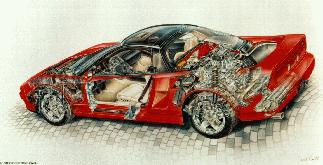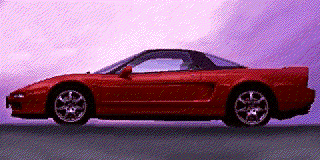

 Used NSX Guide
Used NSX Guide 



|
ENGINES Very strong, suprisingly so considering that they produce 90 hp/liter. Some of the older cars have surpassed 100,000 miles, and we haven't heard of too many that had to be taken apart. At 60K miles or 5 years the cam belt has to be changed, and the spark plugs changed. Neither job is particularly cheap, as the plugs are platinum, but it is unavoidable and really the only major job to be carried out. Coolant should also be changed every 4 years or 48K miles. The electrics are gremlin-free, although cars that are not used often can suffer from battery maladies.
TRANSMISSION |

|
TIRES The fronts last reasonably well and can usually see 12000 miles, but rears wear out in no time. The best you can hope for is 6000, but driven hard you may only get half that. At around $xxx a pair, these have to be worked into your operating costs. There are only a couple of makes that produce OEM-spec NSX tires. Each corner needs a different tire, being both directional and asymmetrical, so make sure the ratings are correct. It is also vital that the car is aligned correctly, and that tires are at the correct pressures. One owner had changed the rear toe-in angle to aid stability, and found he needed a new pair after only 900 miles!
BRAKES |

|
BODYWORK The lightweight aluminum body panels will dent more easily than steel bodied cars, so care has to be taken when closing the bonnet and hood, and if an NSX has been parked at the local KMart it can suffer badly from close encounters with shopping trolleys and other car doors. Any repairs need to be carried out by specialists as this is a skilled job. The low-slung chin spoiler can be gnarled, and flying stones may dent or chip the nose. As there's no steel, rust isn't a worry, neither are leaks from the targa roof. A creaky roof requires more silicone. |

|
INTERIOR Typically Honda/Acura: staid in design, and built to last. Switchgear retains a tight, new feel, even after eight years. The only problems are likely to be scuff marks on the leather from denim studs, and scratches near the ignition from bulky key rings. The struts on the trunk and engine hatch do fail from time to time and need replacing. Make sure the tool kit is complete, and that it still has the air compressor for the compact spare wheel. |

|
SUSPENSION Shocks and dampers are very strong, but they can begin to weaken from about 70,000 miles onwards. Bushings will perish at around the same time, and these will need replacing. |

|
EXHAUST All NSX exhausts are completely stainless steel and rarely need replacing. Check for damage from grounding. |

|
Information presented on this page represents private enthusiasts' opinions, and is not related to, nor endorsed by, The Acura Division of American Honda Motor Co., Inc., Honda Motor Co., Ltd., or any OEM/aftermarket manufacturer. Sections of these articles reprinted/paraphrased from EVO magazine, November 1998. |

|
I will continue to update this site over time... check back once in a while for updates. Enjoy! |



<













